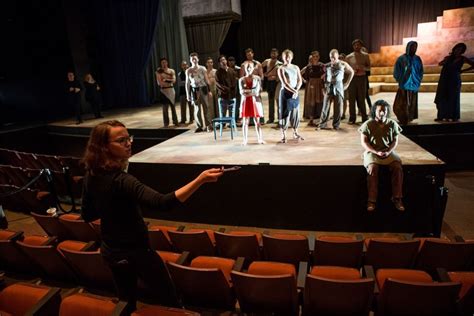Welcome to my blog, where we will be diving into the exhilarating world of theater directing. From working behind the scenes to bring a production to life, to the thrill of opening night, there’s nothing quite like the journey of a theater director. In this series of blog posts, we will explore the various aspects of theater directing, from understanding the role of a director to collaborating with playwrights, casting actors, and overseeing the technical elements of a production. Whether you’re a budding theater director or simply curious about what goes on behind the curtains, this blog will provide insight into the creative and logistical processes involved in bringing a theatrical production from page to stage. Join me as we embark on this exciting adventure into the world of theater directing.
Table of Contents
Understanding the Role of a Theater Director
The role of a theater director encompasses a wide range of responsibilities and skills that are essential to the successful production of a play or performance. It involves overseeing the entire creative process, from developing the initial concept and vision for the production, to working with writers and playwrights to bring the script to life.
Collaboration is a key aspect of the director’s role, as they must work closely with actors, set designers, and other members of the production team to bring their vision to life. This involves casting and auditioning actors, creating a rehearsal schedule and process, and guiding actors in character development and performance.
Another important aspect of a theater director’s role is blocking and staging the scenes, ensuring that the performance is visually engaging and effectively conveys the story. They are also responsible for directing the technical elements of the production, such as sound, lighting, and special effects.
Ultimately, the theater director plays a pivotal role in bringing all of these elements together to create a cohesive and compelling production that will captivate and entertain audiences. They are the driving force behind the creative vision and are responsible for ensuring that the final product meets their artistic standards.
Developing the Concept and Vision for a Production
Developing the concept and vision for a production is a crucial aspect of the theater director’s role. It involves brainstorming ideas, researching themes, and determining the overall look and feel of the play. This process often begins with the director meeting with the playwright or scriptwriter to gain an understanding of the script and its intended message.
Once the script is thoroughly understood, the director can begin the creative process of envisioning how the play will come to life on stage. This may involve creating a mood board, sketching out set designs, or discussing costume ideas with the production team. The goal is to develop a clear concept that will guide the entire production.
Collaboration is key during this stage, as the director works closely with the design team and other creative partners to ensure that the concept aligns with their vision and that all elements of the production will work together harmoniously. This may involve multiple rounds of brainstorming and refining ideas to achieve a unified vision.
Ultimately, the end goal of developing the concept and vision for a production is to create a cohesive and compelling experience for the audience. By putting careful thought and consideration into the overall look and feel of the play, the director sets the stage for a successful and impactful production.
Collaborating with Writers and Playwrights
Collaborating with writers and playwrights is a crucial part of the theater director’s job. This collaboration involves working closely with the creators of the script to bring their vision to life on the stage. It requires a deep understanding of the playwright’s intentions and a willingness to engage in open, respectful communication throughout the creative process.
One of the key tasks in collaborating with writers and playwrights is to understand the themes, characters, and overall message of the play. This involves studying the script in detail, asking questions, and seeking clarity on any ambiguities. It is essential for the director to grasp the essence of the story and its underlying subtext in order to effectively guide the actors and production team.
Furthermore, collaborating with writers and playwrights involves providing feedback and suggestions that can enhance the dramatic impact of the script. This may include proposing changes to dialogue, pacing, or structure in order to better serve the production’s overall vision. It is important for the director to approach this process with sensitivity and respect for the playwright’s artistic integrity.
Ultimately, successful collaboration with writers and playwrights results in a harmonious union of creative minds, leading to a theatrical production that is a true reflection of the combined talents of the entire team.
Casting and Auditioning Actors
When casting and auditioning actors for a production, it is important for a theater director to have a clear vision of the characters they are looking to bring to life. This involves understanding the nuances of the script and the type of actors who would best fit the roles. The process often begins with posting casting calls and holding auditions to find the right talent.
During auditions, theater directors are responsible for guiding the actors through the audition material and observing how they embody the characters. They may ask them to perform specific scenes or monologues, and also evaluate their adaptability and chemistry with other potential cast members.
It is essential for theater directors to maintain a fair and open-minded approach during auditions, as they are seeking to find the best fit for each role. This involves providing constructive feedback to actors and treating them with respect, even if they may not be the right fit for a specific role.
Ultimately, the goal of casting and auditioning actors is to assemble a talented and cohesive cast that can bring the director’s vision to life on stage. By carefully selecting the right actors for each role, the director sets the stage for a successful and compelling production.
Creating a Rehearsal Schedule and Process
Creating a rehearsal schedule and process is a crucial aspect of the theater director’s role. It involves meticulous planning and organization to ensure that the production runs smoothly and efficiently. The schedule must take into account the availability of all actors and crew members, as well as the time required for rehearsals and technical preparations.
Strong communication skills are essential for the director to effectively convey the schedule and process to the entire production team. This includes setting clear expectations and deadlines, as well as maintaining open lines of communication to address any issues or conflicts that may arise.
Additionally, the director must be flexible and adaptable, as changes to the schedule and process are inevitable in the dynamic environment of live theater. This may involve reorganizing rehearsals, adjusting timelines, or accommodating unforeseen circumstances that can impact the production timeline.
In creating the rehearsal process, the director must also consider the specific needs of the actors and the production as a whole. This includes designing a structured rehearsal plan that allows for character development, scene blocking, and the integration of technical elements, such as lighting and sound cues.
Working with Set Designers to Bring the Vision to Life
One of the most crucial aspects of a theater production is the set design, as it serves as the backdrop for the entire performance. As a theater director, working with set designers is a collaborative process that involves bringing the vision of the production to life through the physical environment of the stage.
When collaborating with set designers, it is important to communicate the overall concept and theme of the production. This can include discussing the specific time period, location, and atmosphere that the set should convey, as well as any symbolic elements that need to be incorporated.
Set designers play a key role in translating the director’s vision into a tangible, three-dimensional space. They use their expertise in architecture, art, and design to create a visually stunning and functional set that enhances the storytelling of the production.
Throughout the creative process, the director and set designers engage in a continuous exchange of ideas, feedback, and adjustments to ensure that the set aligns with the overall artistic direction of the production. This collaborative approach ultimately results in a cohesive and impactful visual representation of the director’s vision on stage.
Guiding Actors in Character Development and Performance
Guiding actors in character development and performance is a vital aspect of a theater director’s role. It involves understanding the characters in the script and helping the actors bring them to life on stage. This process requires empathy and insight into human behavior, as well as the ability to communicate effectively with the performers.
One of the key responsibilities in this area is helping the actors develop a deep understanding of their characters. This might involve discussing the characters’ motivations, background, and relationships in order to create a well-rounded portrayal. The director must also provide guidance on how to physically embody the character, from their movements to their vocal delivery.
Additionally, the director plays a crucial role in ensuring that the actors’ performances are consistent and cohesive. This can involve offering feedback and coaching the actors during rehearsals, as well as providing insightful direction during the performance run.
Overall, guiding actors in character development and performance requires a combination of creativity, understanding, and collaboration to bring the characters to life in a compelling and authentic way.
Blocking and Staging the Scenes
Blocking and staging the scenes in a theater production is a crucial component of bringing the script to life. It involves the meticulous planning and direction of the actors’ movements and positions on stage, ensuring that the physicality of the performance complements the emotional and thematic elements of the story.
When blocking and staging a scene, the theater director must consider the spatial relationships between the characters, the overall composition of the stage, and the dynamics of the performance. This process requires a keen understanding of visual storytelling and the ability to guide the actors in creating compelling and meaningful stage pictures.
Effective blocking and staging can enhance the dramatic impact of a scene, drawing the audience’s attention to key moments and creating a sense of rhythm and flow within the production. By carefully orchestrating the movements and interactions of the characters, the director can convey subtext and emotion through the physicality of the performance.
Furthermore, blocking and staging also plays a significant role in the overall pacing and energy of the production. The director must make decisions about when to utilize different areas of the stage, how to transition between scenes, and how to create seamless and engaging transitions for the audience.
Directing the Technical Elements of a Production
Directing the technical elements of a production is an essential aspect of bringing a play or performance to life. The technical elements encompass everything from lighting and sound to special effects and set changes. It is the theater director’s responsibility to work closely with the technical crew to ensure that the vision for the production is effectively realized on stage.
One of the key aspects of directing the technical elements is creating a cohesive and seamless experience for the audience. This involves carefully orchestrating the timing and execution of technical cues to enhance the storytelling and overall impact of the performance. The director must work closely with the lighting and sound designers to ensure that the technical aspects of the production align with the creative vision.
Additionally, directing the technical elements requires careful coordination with the stage crew to ensure smooth transitions and efficient execution of set changes. This involves creating a detailed plan for the movement and placement of set pieces, as well as coordinating with the crew to practice and refine the transitions during rehearsals.
Ultimately, the director’s role in directing the technical elements is to bring together all the technical and creative elements of the production to create a captivating and immersive theatrical experience for the audience.
Opening Night: Celebrating the Fruits of Directorial Labor
As the curtain rises and the lights dim, a palpable sense of excitement fills the air. It’s opening night, the culmination of months of hard work, creativity, and collaboration. For a theater director, this is the moment when all the blood, sweat, and tears that have gone into bringing a production to life finally pay off.
From the initial concept and vision for the show to the grueling rehearsal process, the director has been at the helm every step of the way, guiding and shaping the production into what the audience sees on opening night. It’s a moment of pride and satisfaction, as the director sees their vision come to fruition.
On opening night, the director is also celebrating the talent and dedication of the entire cast and crew. Countless hours of rehearsal, tweaking, and fine-tuning have gone into preparing for this moment, and it’s a time to acknowledge and appreciate the hard work of everyone involved in the production.
As the audience cheers and applauds at the end of the performance, the director can’t help but feel a sense of accomplishment and pride. And as the cast takes their well-deserved bows, the director can bask in the glow of a successful opening night, knowing that their labor has borne fruit in the form of a captivating and memorable production.





